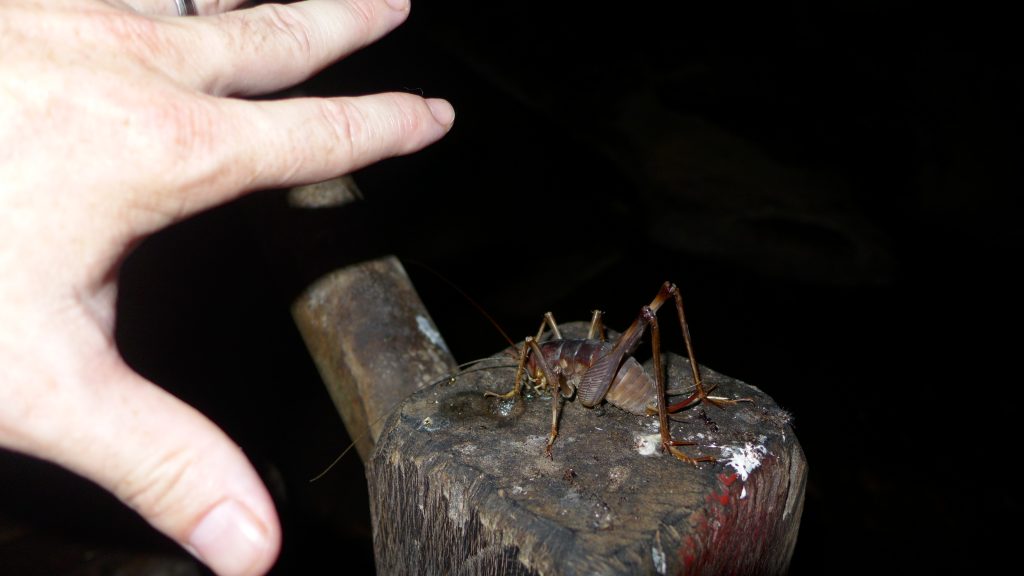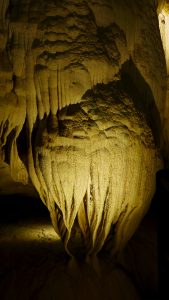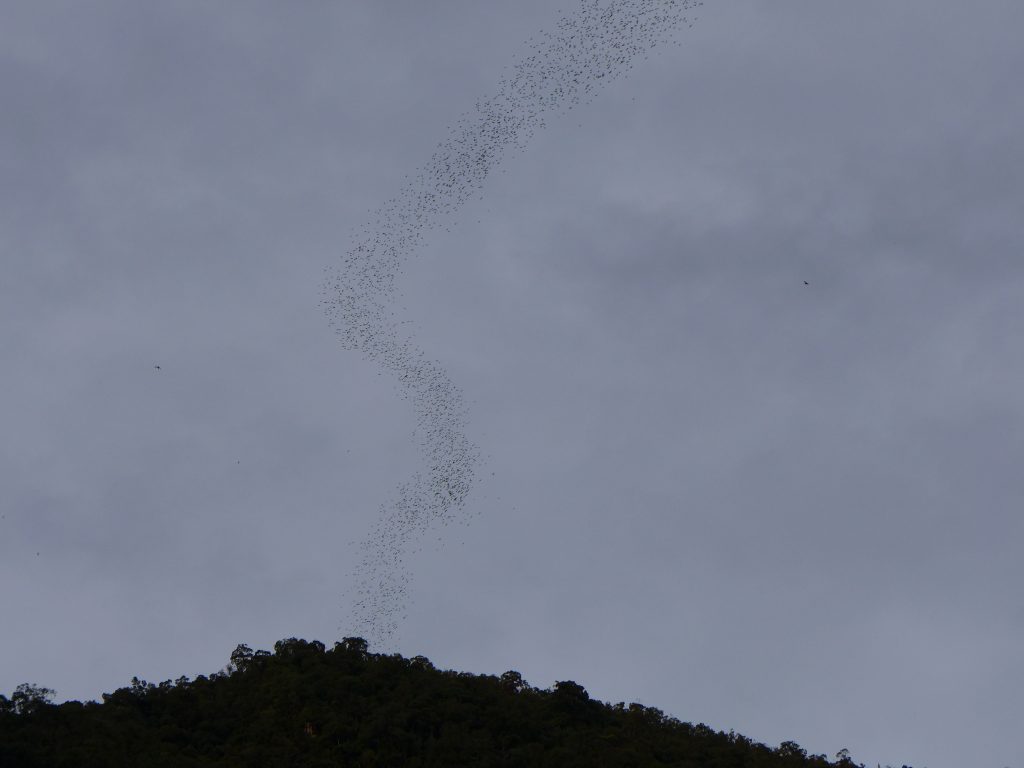
The Caves of Borneo
After leaving Kuching we took our first internal flight into Miri – after buses and trains throughout the rest of our trip, flying is a real luxury. Lucky for us flights are super cheap within SE Asia … though I have to wonder what has happened to cheap flights within America … how come we can’t manage this? We even got a drink and snack onboard the 40 minute flight. In any case we arrived in Miri and after quite some time found an Uber driver willing to take us to the homestay I had booked which was about 20 minute south of the airport. Funny, you would have thought it was 2 hours south the way our driver complained about how far away it was … and we thought wow! 20 minutes is the same amount of time it takes to get out of Pacific Beach and onto the freeway during rush hour … guess it’s all in how you look at things.
We arrived at Treetops Lodge – our ‘home’ for the next few nights. As we (ok I) constantly miss our kitties, we were happy to see that the owners had 4 dogs and 11 kitties!! Heaven! We were using it as a base to go visit Niah National Park known for it’s large limestone caves and more importantly for its ‘painted cave’ with paintings dating back 1200 years. In fact the cave we were to visit had been continuously inhabited from 40,000 years ago up until 2000 years ago. Now when I say cave you might be thinking of a small cave but think again – this cave is huge. Actually not as big as the caves we would visit in Mulu National park but still really, really big.
Arriving in Niah parking lot, you could tell it wasn’t one of the more visited parks we had been to – but we thought – cool it we will have the park all to ourselves. The walk to the caves was easy – as you walk through marsh and next to rivers (that often flood with the heavy rains) they had built boardwalks so compared to all the walks we had done in both Bako and Kubah this was going to be a piece of cake … or so we thought.
After a 3km walk you arrive at the entrance of the ‘Great Cave’, up until the 1970’s local people would still come into the mouth of the cave and camp out for a few months as they farmed the swiftlet’s nest to sell for birds nest soup. Ok, let me digress a moment, yes people actually pay a lot of money to buy birds nests, to eat. But what are these birds nests made of? Straw? Sticks? Nope it is their saliva … pretty weird huh?! Apparently it has the texture of drool too… yummy. Inside of the caves are these giant bamboo poles that go hundreds of feet to the ceiling – one guy shimmies up and knocks down the nests by candlelight and his partner picks them up. Nowadays they close down the caves for 4 months per year to allow the harvest to go on – in a controlled manner, in this way they don’t have illegal harvests and they can ensure some protection to the swiftlets.
In any case we entered the mouth of the cave and followed the board walk up into its interior. There were a bunch of stairs to climb and the smell of guano (shit) wafted up into our noses … it was pretty overpowering but like anything, you got used to it. You can hear the swiftlets flying about with their shrill songs. The Great cave is about 1km long and 1/2 km high though the cave system continues on well after this first part, while the whole boardwalk route through the cave is about 3km. As this park is less visited you can explore the caves on your own (without a guide) which is pretty cool as you can take your time walking around. A little less cool is the sheer danger of it as once you are inside of the inner cave there are no lights, no hand rails, the board walk is slippery with guano and slime and if you fall off the boardwalk you would probably be lost to the world … FOREVER.
Once you leave the Great cave you enter an enormous chamber where you can see the jungle via an exit to one side and through giant holes in the ceiling 100’s of feet up. It is an impressive site to see these caves and think about how many people had walked in our steps before us … ok they probably didn’t have boardwalks but still.

After the big chamber we went down some stairs into the dark section. It is literally black down there – so dark that when we turned off our headlamps we couldn’t see our hands in front of our faces. This is where the boardwalk’s condition notably deteriorated .. for a while I tried to cling to the handrails that remained to keep from sliding on the slime and falling on my ass, that is I tried until I noticed that there were these giant crickets hanging out on the handrails. Neither Kevin nor I had ever seen any insects this big – I mean their thighs were as big as frogs legs and they were creepy. After that we started seeing them everywhere so I kept my hands to myself and shuffled along, hoping not to slide off the edge of the boardwalk and get eaten alive by these creatures. Ok… I exaggerate but it’s pretty scary down there.

We finally made it out the other side, checked out the painted cave with the 1200 year old cave drawings…. I have to say they are pretty faded and you really had to use your imagination to see anything but it was pretty neat to see where people had lived .. it looked like a really nice cave :). We had to go out the same way we came in so on our way out of the cave – after the halls of darkness, Kevin all of a sudden said ‘did you see that?’ Um, no I am just full steam ahead and outta here, I thought. Then he said – Keep moving … ok, that’s a bit concerning. I kept moving and turned around when I thought I was safe and there it was a giant snake – probably around 5 feet.. I was lucky I didn’t step on his head. No signs anywhere warning us about giant crickets, cave snakes, slimy boardwalks or caves that were black as night. We made it out alive … and yes! it was exhilarating and fun. We made it back to our rental car and drove back to our lodge in the jungle. The next day we lounged around and enjoyed the owners pets and gorged on her homegrown pineapple and dragon fruit before catching our next flight towards Mulu National Park.
The flight into Mulu was really cool, we flew over miles and miles of jungle with no habitations in site. Flying is pretty much the only way to get into Mulu unless you take a multi day trip on logging roads. Unfortunately, Borneo as much of the rest of the ‘1st world’ is money hungry. What does that mean? They are cutting down their rainforest at an alarming rate and planting palm trees to harvest palm oil. I saw a quote that pretty much sums it up :
Only when we have caught the last fish, killed the last animal and cut down the last tree will we finally understand that we cannot eat money. Pretty scary, right? Did you know that 50 species go extinct every day? That’s almost 20,000 a year … let’s do something about it. PLEASE.
Mulu National Park is a World Heritage Site, one of only 20 on planet Earth that meet all 4 criteria. It contains some of the biggest limestone caves in the world including the biggest enclosed space in the world – Sarawak cave (2300 feet long and 1300 feet long and over 230 feet high!) as well as the biggest single passage cave – Deer Cave. Deer Cave is one of the reasons we came to visit this park, it is home to over 2 million bats and every night they exit the cave at dusk to search for insects.
We visited two caves while we were there the Lang cave, which isn’t huge but thought to be at least 40 million years old with an impressive array of stalagmites and stalactites. Unlike Niah all of the cave visits are guided, you can tell a lot more focus has been given to this park as the interior is lit up, the boardwalks are in excellent condition and the guano and slime are regularly power washed off. A bit of a bummer really … I liked the adrenaline rush experience a little better. That being said, the Lang Cave and then the Deer Cave were incredible. Lang Cave for its rock formations and Deer Cave for the incredible size of it. In Deer Cave you could see giant black spots on the ceiling which were groups of bats. All waiting to come out at dusk, or so we hoped.

We got lucky on our second foray to see the bats, the first day it was raining so they don’t come out but on our second night the weather cleared and the bats were hungry. It was incredible to see them come out by species, since there are over 12 different kinds of bats that live in the cave (over 50 species have been discovered in Mulu with more discovered every year)!. They would come out of the cave in spirals, in donut shapes or just in a large wavy line. The exit went on for 30 minutes and was INCREDIBLE! Did you know if we didn’t have bats there would be no mangoes? Don’t you just love bats now??

On the mammal front, we hadn’t really seen much wildlife at Mulu or at Niah. The parks are so big that it is quite difficult to see the wildlife. We did see a great number of creepy crawlies such as stick bugs, spiders, millipedes, frogs and lizards but on our last night when we were walking along the boardwalk at night we saw a moon rat, which was a white rat the size of a possum. Kind of the mammal highlight of our recent national park stay.
After 3 nights in a dorm room. yes I have sworn off ever staying in a dorm again, we hopped on our next flight to Kota Kinabalu, our first stop in Sabah, the other Malaysian state in Borneo. We were very lucky as there were only 6 people on our flight so we got unlimited beverages, all for $25 … again, America, WTF?! Why can’t we do this too?
After all this wandering I was looking forward to staying in a nice A/C room with private bathroom .. a girl can dream right? Unfortunately our guest house was right next to an outdoor bar … they blasted music until 1am every night and our room was right over it … I could have cried. Good thing there were cheap foot massages to be had … I consoled myself with an hour of bliss for only $10…. Always look on the bright side of life….
–
2 thoughts on “The Caves of Borneo”
Please please stay out of caves in the future! I was scared just reading about it.
what a slimy affair. But again, a new experience. And as far as smell is concerned, just think of the people in La Jolla with their million dollar homes that have to smell the seals and sealions!!!